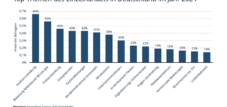Crafts are the essential element of our entire economy: bureaucracy and a lack of skilled workers hinder development
Language selection 📢
Published on: September 5, 2024 / update from: September 5, 2024 - Author: Konrad Wolfenstein

Crafts are the essential element of our entire economy: bureaucracy and a lack of skilled workers hinder development - Image: Xpert.Digital
🛠️📉 The backbone of the economy: The immense importance of craftsmanship
🛠️👷 Crafts are the essential element of our entire economy
Crafts form the backbone of our economy. It is not only an essential part of the economic structure, but also plays a crucial role in the daily supply of the population. From construction to maintenance, from individual trades to specialized services – the trades cover a variety of industries and make a decisive contribution to value creation.
The importance of craftsmanship can be seen not only in numbers, but also in the role it plays in society. Craftsmen ensure that basic needs such as housing, food, clothing and mobility are met. Skilled trades are particularly important in Germany, where the dual training system is firmly established. However, despite this fundamental importance, the craft is faced with a number of challenges that are hindering its development.
🗂️ Bureaucracy
One of the biggest obstacles is bureaucracy. Many craft businesses struggle with a veritable flood of rules and regulations that make their day-to-day business more difficult. Instead of being able to concentrate on their core tasks, they are forced to invest more and more time and resources in administrative tasks. The bureaucratic hurdles not only affect large craft businesses, but especially small and medium-sized companies, which form the backbone of the craft industry. Whether it's applying for permits, complying with safety regulations, or dealing with tax issues, there are complex requirements lurking everywhere that create an unnecessary burden.
👨🔧 Skilled labor shortage
Another key problem is the shortage of skilled workers. This is no longer just a future scenario, but rather a bitter reality in many regions. Many companies are desperately looking for qualified personnel, but often cannot find suitable applicants. There are many reasons for this: demographic change, increasing academization and the decline in birth rates mean that fewer and fewer young people are starting skilled trades training. In addition, skilled trades have lost social prestige in recent years, which means that many young people are more likely to pursue an academic career rather than opting for the skilled trades.
📉 Challenge and development
“Crafts are the heart of our economy,” many experts emphasize again and again. And it actually shows that without craft businesses, many everyday processes would no longer function. But it is precisely the combination of bureaucracy and a shortage of skilled workers that poses a significant threat to the future of the skilled trades. While, on the one hand, bureaucracy slows down many processes and limits the flexibility of craft businesses, the shortage of skilled workers means that fewer and fewer businesses are able to process their orders to be fulfilled in a reasonable time. This not only has economic consequences, but also affects the quality of services offered to consumers.
🔍 Solutions
The question now is how to overcome these challenges. On the one hand, political measures are necessary to promote the reduction of bureaucracy. Politicians must recognize that crafts play a key role in economic prosperity and must be relieved accordingly. This could be done by simplifying regulations, introducing digital processes to reduce administrative tasks and creating a clear legal framework specifically tailored to the needs of craft businesses.
🚀 Measures and digitalization
On the other hand, the shortage of skilled workers must also be addressed. Various measures are also conceivable here, ranging from better career orientation in schools to a reform of the education system. Crafts in particular must be repositioned as an attractive option for young people. However, this not only requires an image campaign, but also concrete improvements to working conditions in many skilled trades. This includes fair pay, but also the opportunity for further training and opportunities for advancement within the industry.
In addition, digitalization could play an important role in overcoming these challenges. Many craft businesses have already taken the first steps towards digitalization in recent years, be it through the introduction of online booking systems, the use of social media to attract customers or the use of modern technologies in order processing. But the potential of digitalization is far from exhausted. There are still many untapped opportunities, particularly in areas such as the automation of work processes, the use of data analysis to optimize business processes or the introduction of digital training opportunities.
📱 Digital challenges and opportunities
However, it must be emphasized that digitalization cannot solve all problems. Many activities, especially in the skilled trades, are heavily influenced by human expertise and direct customer contact. It will therefore always be important to have well-trained specialists who master their technical skills and at the same time are able to use modern technologies sensibly.
Despite the challenges it faces, crafts remain a central pillar of our economy. However, bureaucracy and skills shortages are serious obstacles that must be urgently addressed to secure the future of the craft sector. Both political support and a social rethink are needed to strengthen crafts as an attractive and indispensable sector of the economy. This is the only way crafts can continue to successfully fulfill their important role in the economy and in people's daily lives in the future.
📣 Similar topics
- 🛠️ Importance of crafts for the economy and society
- 📉 Challenges in crafts: bureaucracy and shortage of skilled workers
- 🚀 Digitalization in crafts: opportunities and potential
- 🎓 Crafts and the dual training system
- 👷♂️ Skilled labor shortage in the trades: causes and solutions
- 📑 Reducing bureaucracy: Political measures for the craft sector
- 🌍 Craftsmanship as the key to economic value creation
- 📈 Crafts in transition: future perspectives and strategies
- 💡 Innovations in crafts: Modern technologies and solutions
- 🤝 Strengthen the social reputation of crafts
#️⃣ Hashtags: #Crafts #Skills shortage #Digitalization #Bureaucracy reduction #Economy
🏗️ Business situation in German crafts
Suitable for:
📈 According to the Central Association of German Crafts (ZDH), the craft industry achieved an impressive turnover of around 766 billion euros in 2023. This shows how important crafts are for the German economy. A survey from spring 2024 shows that around 55 percent of craft businesses rate the current business situation as “very good” or “good”. This optimism is a sign of the robustness and resilience of the sector, which remains strong even in times of economic challenges.
📉 However, there is also another side: Seven percent of companies stated that they find the business situation to be “poor” to “unsatisfactory”. This suggests that not all companies were able to benefit from the positive overall development. Smaller and specialized craft businesses in particular often struggle with rising costs and tough competition.
💹 A notable trend over the last two years is the increase in asking prices in the craft sector. In spring 2024, around 67 percent of companies reported that they had had to increase their prices in the last few months. This can be attributed to several factors, including rising material costs, higher labor costs and increased energy costs, which are placing strain on many businesses.
📉 The development of insolvencies in the craft sector is particularly relevant. While around 6,500 bankruptcies were reported per year in 2009, this number fell significantly in the following years until it reached a low in 2022. But in 2023 the number of bankruptcies rose again and was over 4,000 cases. This is a worrying development and could indicate structural problems in the sector, such as insufficient liquidity or a lack of qualified talent in certain professions.
🛠️ Crafts are often referred to as the backbone of the German labor market, and for good reason: around 12 percent of the workforce in Germany, which is around 5.6 million people, are employed in crafts. This figure underlines the importance of the sector not only for the economy, but also for the country's social stability, as crafts provide a variety of jobs that are often not available to the same extent in other sectors.
👷 Employment and training in crafts
📚 Another essential aspect of the craft is the training of new skilled workers. In 2023, there were around 342,000 apprentices who completed training in the skilled trades. This number has fallen slightly compared to the previous year, which points to a general problem: the lack of young talent. Since 2000, the number of trainees in the skilled trades has fallen by around 40 percent overall. The reasons for this are varied. One of the main factors is that more and more young people are aiming for an academic career and are opting for university studies rather than vocational training.
📈 Nevertheless, there are also positive developments: The number of newly concluded training contracts increased slightly in 2023 and was around 130,400 contracts. This shows that the skilled trades are still attractive, especially for young people who prefer practical training. However, the challenge remains to make the craft attractive to more school leavers, especially those with a higher level of education.
🎓 The fact that a large proportion of school leavers in Germany decide to study poses additional challenges for the craft industry. In 2023 in particular, only around 21,400 new training contracts were concluded by people with a university entrance qualification. This means that the skilled trades depend primarily on young people with a secondary or secondary school qualification. To counteract this, targeted measures must be taken to make the craft more attractive for high school graduates. These include, among other things, improved career opportunities, greater social appreciation of skilled trades, and targeted advertising measures to highlight the diverse benefits of skilled trades training.
🔧 Particularly popular professions among apprentices in the trades continue to be automotive mechatronics technicians, electronics technicians and system mechanics in the areas of plumbing, heating and air conditioning technology. These professions not only offer good career prospects, but are also indispensable in society due to the high demand for these services. In addition to these classic crafts, professions such as carpentry and hairdressing continue to enjoy great popularity.
🔮 Challenges and future prospects of craftsmanship
🏭 Although crafts have a long tradition in Germany and still play an important role in the economic system, many companies face major challenges. A crucial problem is the shortage of skilled workers, which has worsened in recent years. Many craft businesses report that they cannot fill vacancies because there is a lack of qualified applicants. This shortage of skilled workers not only affects the companies themselves, but also the economy as a whole, as many orders cannot be processed or can only be processed with considerable delays.
🖥️ Another important point is digitalization in crafts. Many companies are faced with the challenge of integrating digital technologies into their work processes. This not only applies to administration and organization, but also to the use of modern tools and techniques in practical craftsmanship. Digitalization offers many opportunities, for example through more efficient work processes and the development of new business areas, but at the same time many craft businesses need support in order to successfully manage this transformation.
🌍 The topics of sustainability and climate protection are also becoming increasingly important in crafts. More and more customers are attaching importance to the use of environmentally friendly materials and methods when carrying out craft services. Craft businesses that are able to meet these requirements can gain clear competitive advantages in the future.
🔮 Overall, German crafts face an exciting but also challenging future. On the one hand, technological change and the increasing demand for sustainable solutions offer new opportunities; on the other hand, companies have to master the challenge of a shortage of skilled workers and increasing competition from abroad. But with its flexibility, innovative strength and deep roots in German society, crafts have the potential to continue to play a central role in the country's economic and social structure in the future.
📣 Similar topics
- 📈 Business situation in German crafts
- 💡 Challenges in crafts
- 🛠️ Importance of German crafts
- 📊 Sales development in the craft sector in 2023
- 💷 Price developments and costs in crafts
- 🏢 Bankruptcies and their effects
- 👷 Skilled labor shortage in the craft sector
- 🌍 Sustainability and climate protection in crafts
- 🚀 Digitalization and technological innovations
- 👨🔧 Apprenticeships and young talent in the craft sector
#️⃣ Hashtags: #Crafts #Economy #Skills shortage #Sustainability #Digitalization
We are there for you - advice - planning - implementation - project management
☑️ SME support in strategy, consulting, planning and implementation
☑️ Creation or realignment of the digital strategy and digitalization
☑️ Expansion and optimization of international sales processes
☑️ Global & Digital B2B trading platforms
☑️ Pioneer Business Development
I would be happy to serve as your personal advisor.
You can contact me by filling out the contact form below or simply call me on +49 89 89 674 804 (Munich) .
I'm looking forward to our joint project.
Xpert.Digital - Konrad Wolfenstein
Xpert.Digital is a hub for industry with a focus on digitalization, mechanical engineering, logistics/intralogistics and photovoltaics.
With our 360° business development solution, we support well-known companies from new business to after sales.
Market intelligence, smarketing, marketing automation, content development, PR, mail campaigns, personalized social media and lead nurturing are part of our digital tools.
You can find out more at: www.xpert.digital - www.xpert.solar - www.xpert.plus


























